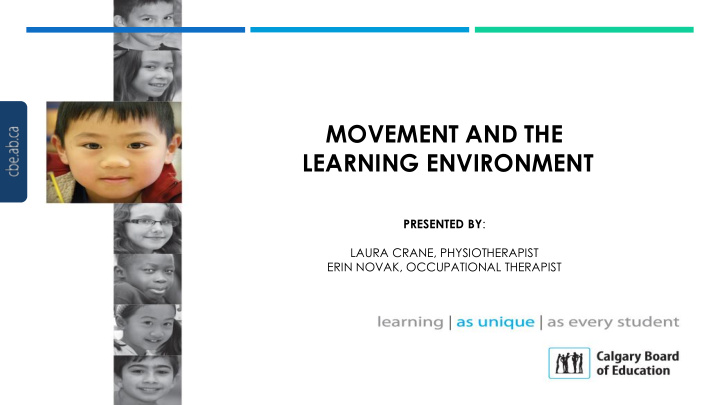



MOVEMENT AND THE LEARNING ENVIRONMENT PRESENTED BY : LAURA CRANE, PHYSIOTHERAPIST ERIN NOVAK, OCCUPATIONAL THERAPIST
IMPORTANCE OF MOVEMENT Optimize the brain’s ability to learn Increase blood flow (oxygen) to the brain Increase brain growth and development Increase neuron creation and resistance to stress Release dopamine, a mood-enhancing neurotransmitter Improve memory Regulate emotion Increase motivation, alertness and attention Decrease depression, anxiety and anger
MOVEMENT AND LEARNING Promotes Regulation! • Increase student alertness : Sitting and listening for too long can put parts of the brain to sleep. Wake up your students’ brains to • o absorb and retain information o Be alert and ready to do their best work Release excess energy to help calm the body and mind, especially when high intensity followed by activities that involve heavy work ( calming and organizing)
PHYSICAL DEVELOPMENT BENEFITS Increased core stability and strength Increased endurance Improved motor coordination Improved balance Improved fine motor control 4
“Eat well and exercise” - We’re not doing it 9% of Boys & 4% of girls The Canadian Physical Activity (2012) are meeting this guideline = 60 min / day guideline mod-vigorous physical activity Slide / 5
24 HOUR MOVEMENT GUIDELINES FOR AGES 5-17
LET’S KEEP MOVING….HERE’S HOW: Classroom set up (we’ll address in the 2 nd half!) 1. Movement/Heavy Work Breaks 2. Hallway transitions 3.
CLASSROOM MOVEMENT BREAKS Movement Breaks Movement Cards Movement Games Yoga Videos GoNoodle, Dance, Cosmic Yoga Try a Pre-noodle!
MOVEMENT STRATEGIES BE ACTIVE BE STRONG BE READY TO LEARN
BE ACTIVE Short Bursts of High Intensity Activities Goals: Increase heart and respiratory rate Increase alertness Release excess energy
BE STRONG POSITIONS and EXERCISES Goals: Develop core stability and strength Heavy work sensory input for self regulation
BE READY TO LEARN Calming Activities Goal: Assist students in achieving optimal state of regulation for learning
WHEN TO INCORPORATE MOVEMENT Whole Class Designate specific times/ regularly scheduled First thing in the morning Right after recess or lunch (busy, loud, unstructured times) Just before an activity requiring concentration and focus (deskwork) When you notice low energy – to help ‘wake up’ the body When you notice high energy – to help calm the body
WHEN TO INCORPORATE MOVEMENT Individual or Small Groups o Extra sessions for students with regulation challenges o Target individual student gross motor needs – core strength, endurance, flexibility, balance, etc.
HALLWAYS AND TRANSITIONS Transitions - silly walks, jump to reach/tag something Bench activities
Movement Break!
LEARNING ENVIRONMENT: WHY IS IT IMPORTANT?? An effective learning environment will: Create predictability and stability Enhance learning and participation Clarify expectations and cues Foster student independence and readiness to learn Support successful transitions and routines Address diverse learning styles Allow for natural learning opportunities …for all students (Kabot & Reeve, 2014, p. 9-10)
ESTABLISH CLASSROOM CULTURE • Setting the tone for the how diverse learning needs are acknowledged and addressed • Setting clear rules and routines, accompanied by visuals, creates consistency and predictability • Learning and creativity is not turned on like a switch but continually fostered throughout the day
LEARNING ENVIRONMENT COMPONENTS Sensory Impact Need for Microenvironments Varied Work Spaces Classroom Flow and Ease of Movement Visuals and Organization Classroom/School Culture
VISUAL Natural vs artificial lighting Experiment with lighting options Focused lighting for attention Tri-folds to limit visual distraction Limit extraneous visual materials Use basic, natural light colours Keep clutter to minimum Use nature elements Variety of visual format Handouts easy to read
AUDITORY Eliminate unnecessary auditory sounds Cover the bottom of chairs and desks Experiment using different sounds during work times Allow for noise reducing tools as needed for individual work or during tests. Use musical objects or patterned music to signal transition rather than using your voice.
SMELL AND TOUCH Smell: Explore room scents Offer individualized scents Touch: Consider various fabrics or textures Explore multi-sensory methods Offer alternatives Notice temperature (too hot or too cold)
PROPRIOCEPTION AND VESTIBULAR Strategies to Support Movement and Balance: Different Seating Positions Natural Movement Breaks Movement Invitations
CREATING MICROENVIRONMENTS Classroom Microenvironments : Smaller places in the classroom that will address a variety of learning needs. A classroom with microenvironments will have areas to: Change a body position, as needed Down-regulate or calm Up-regulate or energize Reduce extra sensory stressors
FLEXIBLE CLASSROOM DESIGN
QUIET ZONE-QUIET AREA TO DO WORK
CALMING ZONE
VARIED WORK SPACES Allow for various learning needs: Small Group/Collaboration Individual 1:1 with Teacher Whole Group Computer/Media
THE CLASSROOM ENVIRONMENT Classroom arrangement Space for movement breaks without moving anything Energy and Movement stations Area where students can do jumping jacks, pace around, bounce on a large exercise ball or stretch out elastic thera-band, do chair or wall push-ups.
THINK TO ADD MOVEMENT TO CURRENT FURNITURE OR CLASSROOM PRACTICES. Air-cushions • Foot-fidget: bands on desk legs, bungee cords • Use old office chairs by taking off the wheels and use as swivel • chairs
THINK ERGO-DYNAMIC SEATING Use furniture that promotes a change in posture naturally and continually . Swivel chairs Rocking chairs Hokki stools Standing desks and stools Rocker bar for feet Ball chairs
MAKE PEACE WITH FIDGETING…. This behaviour is the body’s way of supporting the brain….
THINK OUTSIDE OF THE BOX…
AROUND THE CBE…
AT CHINOOK PARK
MAKING IT RELEVANT TO CHINOOK PARK • Cost Constraints? • Decide what HAS to stay • Time Constraints? • Involve the students in the • Actual Physical Space? planning process • Personal Preferences? • Working group @ school
AND FINALLY…
Recommend
More recommend